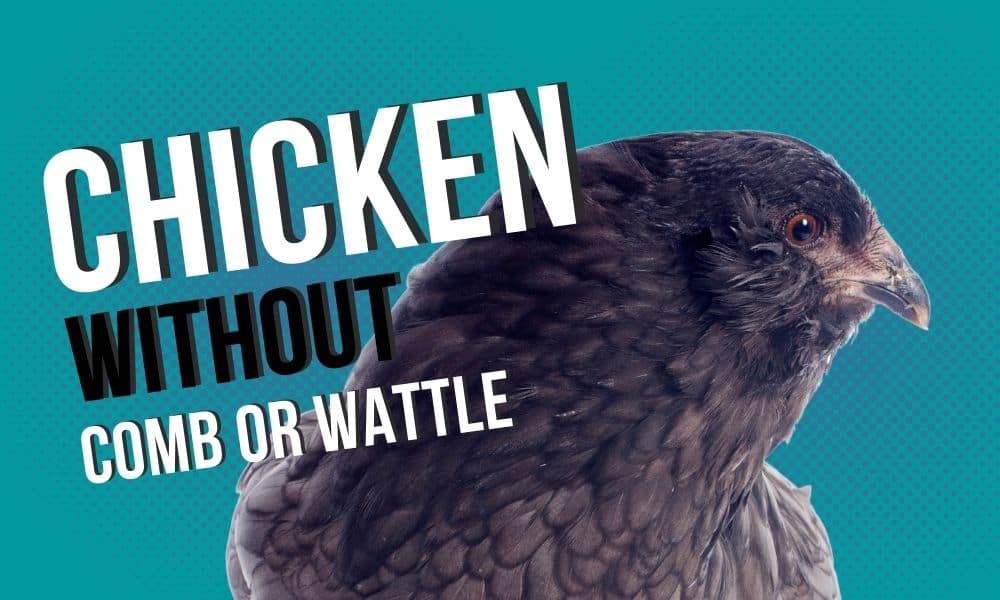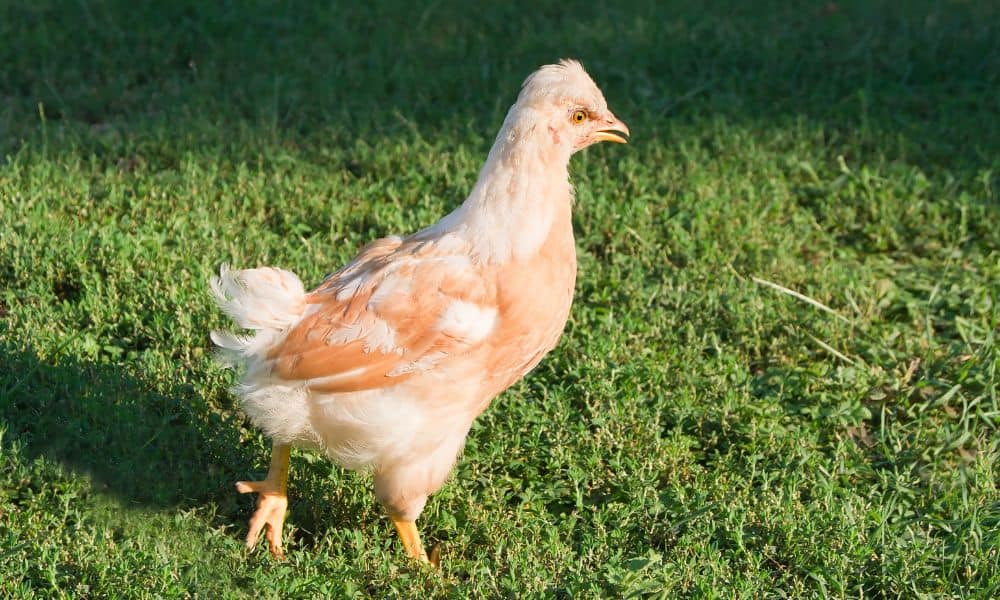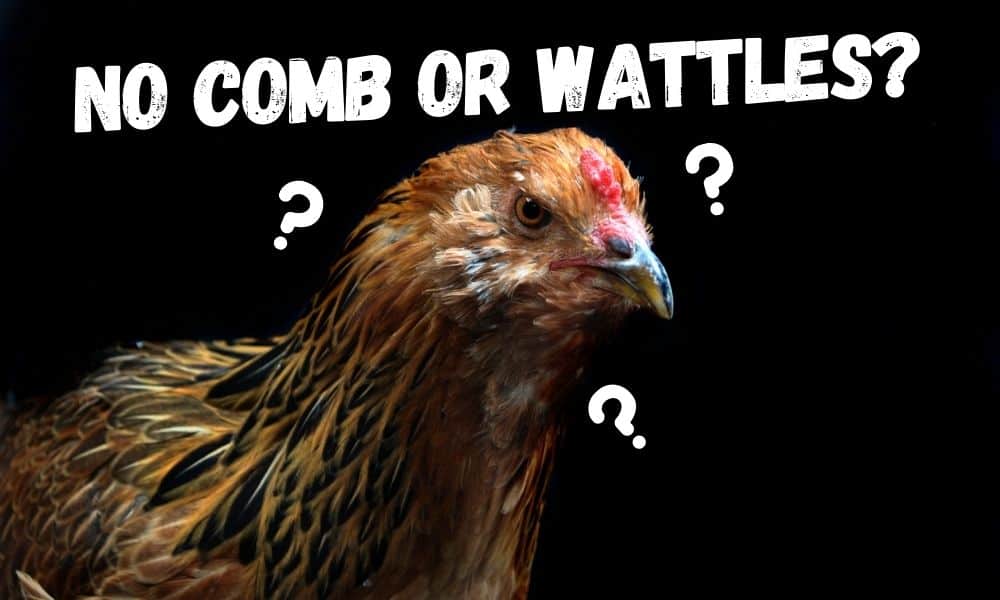Chickens are famously identified by their big fluffy feathers, their big red combs on their head, and red, dangly wattles below their beak.
But, just because this is what a typical, traditional chicken looks like, doesn’t mean all breeds or chickens conform to these rules.
What’s fascinating is coming across a chicken without a comb or wattle at all!
So, whether you’re raising your own chickens or you’re merely curious, here’s what would explain a chicken without a comb or wattle, what combs and wattles are actually good for, and what breeds of chickens have small or even no combs or wattles.
Contents
Chicken Without Comb Or Wattle: Is It Possible?

Although big red combs and wattles are iconic for a chicken, it doesn’t mean every single chicken has them!
In fact, there are some breeds of chickens that don’t have a comb or wattle at all, like the Aracuana which sports a muff and beard instead!
What’s more, you’ll find that cold hardy chicken breeds that have adapted to colder climates will almost always have smaller combs and wattles than those developed in warmer regions.
It’s also important to note that young chickens, both males and females, often don’t grow their combs or wattles until they begin to mature.
So there are such things as chickens without combs or wattles, seen in both young chickens and in specific breeds!
A Word About Young Chickens Without Combs Or Wattles

If you’re raising chickens for the first time and you’re a bit confused as to why they don’t have any combs or wattles yet, don’t stress about it.
It’s completely normal for baby chicks, young hens (pullets), and even young roosters (cockerels) to not display any combs or wattles.
This is because they normally grow when the chicken begins to mature.
Across most breeds of chicken, roosters will start to grow combs and wattles by as young as 8-12 weeks old. However, hens normally take a while longer to grow their combs and wattles out and tend to do so from 12-16 weeks old.
This is handy knowledge to possess if you’re raising your own chickens, as the appearance of combs and wattles in a group of young chickens can be used as an identifier of a rooster (or at least help build your case!).
What Are Combs And Wattles Used For?
The primary function of the comb and wattle on chickens is to help regulate their temperature.
More specifically, combs and wattles help the chicken keep cool by taking on the colder temperatures from the outside environment or wind, and circulating it to the rest of its body.
The same kind of process occurs with their feet too! Since chickens are warm-blooded, they need to constantly regulate their temperature to survive!
But, aside from the thermoregulation, combs and wattles also help chickens by:
- Advertising The Prowess Of Roosters (i.e showing off to the hens)
- Improve Desirability In Hens (i.e. showing off to the roosters!)
- Provide A Health Check To Their Flock & Owners (discolored combs and wattles can indicate sickness or illness)
Chicken Breeds With Small/No Combs Or Wattles

If you’re after a specific look for your flock, or if you live in a particularly cold climate, you might just be on the lookout for these amazingly gorgeous smalled combed/wattled chooks!
Here are just some of the very many chicken breeds with small combs or wattles, or even no combs or wattles!
Araucana
The Araucana is a pea-combed and blue egg-laying breed from Chile. Although much rarer than the more popular Ameraucana or Easter Eggers, it’s one of the few heritage breeds that lay colorful eggs!
North American Araucanas are rumpless (without a tail) and have long ear tufts and no wattles at all!
Ameraucana
The Ameraucana is an American descendant of Araucanas. Like its predecessor, it normally lays blue-shelled eggs, but it can also lay green or even speckled eggs.
It has a pea comb and a tiny/absent wattle as well.
Easter Egger
The Easter Egger is another pea-combed chicken with little to no wattle.
Technically Easter Egger isn’t actually a breed, but it refers to those chickens which are mixed with at least one blue egg layer – so it too lays blue or green eggs!
Brahma
The Brahma is another American pea-combed breed. Its heritage stems from the Shanghai bird of China.
These chooks can grow mighty large, but usually, it’s only the roosters that sport large combs and wattles compared to the hens.
Malay
The Malay is a game fowl with a tiny pea comb and no wattle.
To be quite honest with you, they look more like an ordinary bird than a chicken – mainly due to their slim bodies and lack of wattles.
Chantecler
The Chantecler is quite a unique chicken breed, sporting a bit of a comb-over hair style which often hides their very small combs.
The hens usually go without wattles entirely and the roosters don’t grow large wattles by rooster standards.
Main Takeaways
So if you’ve seen a chicken running around with no combs or wattles – don’t worry you’re not going mad!
It’s very possible for chickens to have little to no combs or wattles!
In fact, baby chicks to young chickens in the early ages don’t have combs or wattles at all, as they only grow in from about 6-12 weeks.
However, even at maturity there are those chicken breeds like Araucana or Ameraucana which don’t end up growing combs and wattles at all.
This is thought to be because they were originally bred and developed in colder climates, where large combs and wattles are seen as a disadvantage.
Happy backyard farming everyone!
